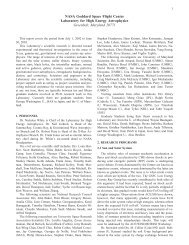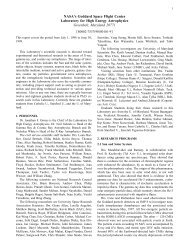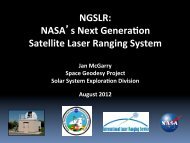Part 2 - NASA
Part 2 - NASA
Part 2 - NASA
Create successful ePaper yourself
Turn your PDF publications into a flip-book with our unique Google optimized e-Paper software.
Research and Development of<br />
High-End Computer Networks at GSFC<br />
Presented at the Earth Science Technology Conference 2003<br />
University of Maryland Conference Center<br />
http://esto.nasa.gov/conferences/esto2003/<br />
J. Patrick Gary<br />
Network Projects Leader<br />
Earth and Space Data Computing Division/Code 930<br />
<strong>NASA</strong> Goddard Space Flight Center<br />
pat.gary@nasa.gov<br />
301-286-9539<br />
June 25, 2003<br />
6/25/03<br />
J. P. Gary<br />
1
Research and Development of<br />
High-End Computer Networks at GSFC<br />
Outline<br />
● Motivation<br />
● Challenge<br />
● nuttcp Performance Testing Tool<br />
● Evaluations in Large Bandwidth*Delay Networks<br />
» Examples of Pre-2000 Efforts<br />
» Examples of Current Evaluations<br />
● Conclusion<br />
6/25/03<br />
J. P. Gary<br />
2
Research and Development of<br />
High-End Computer Networks at GSFC<br />
Motivation<br />
● Availability of new high-bandwidth networking<br />
technologies, e.g.:<br />
» 1-10 Gigabit Ethernet switches/routers<br />
» Wave division multiplexing on dark fiber<br />
● New (and old) types of bandwidth-demanding<br />
applications, e.g.:<br />
» Streaming HDTV and other real-time data over IP<br />
networks<br />
» Storage Area Networks over IP networks<br />
» High end computing<br />
6/25/03<br />
J. P. Gary<br />
3
DATA MOVED VIA NETWORK PER RUN (BYTES)<br />
from central computer to Investigatorʼs local environment<br />
15<br />
10<br />
10<br />
14<br />
10<br />
12<br />
10<br />
11<br />
10<br />
10<br />
10<br />
9<br />
10<br />
10<br />
8<br />
7<br />
10<br />
10 8<br />
Lower<br />
resolution<br />
1 teraBYTE<br />
CRAY<br />
XMP/48<br />
J.Fischer/<strong>NASA</strong> GSFC, 981208<br />
Long Haul Network vs CPU Requirements<br />
of ESS Grand Challenge Investigators (Science Team #2)<br />
Medium<br />
resolution<br />
10 9<br />
1<br />
Preferred<br />
resolution<br />
T: Duration of run (Hours)<br />
M: Main memory (teraBYTES)<br />
D: Disk size (teraBYTES)<br />
MS: Mass storage size (teraBYTES)<br />
16-head<br />
CRAY C-90<br />
Science<br />
Team #1<br />
FY93-96<br />
(5 GFLOPS)<br />
10 10<br />
1024-processor<br />
CRAY T3E<br />
Science<br />
Team #2<br />
FY96-99<br />
(100 GFLOPS)<br />
10 11<br />
T: 1Hr<br />
M: .13TB<br />
D: .06TB<br />
MS: .5TB<br />
T: 480Hr<br />
M: .12TB<br />
D: .7TB<br />
MS: 8.0TB<br />
3<br />
T: 200Hr<br />
1 M: .26TB<br />
D: .05TB<br />
T: 24Hr MS: 6.0TB<br />
M: .16TB<br />
T: 100Hr<br />
D: .64TB<br />
M: .12TB<br />
MS: 6.4TB<br />
D: .04TB<br />
MS: .08TB<br />
PROCESSOR SPEED (FLOPS)<br />
8<br />
6<br />
2<br />
Science<br />
Team #3<br />
FY00-02<br />
(1 TFLOPS)<br />
T: 1,500Hr<br />
M: .1TB<br />
D: 1.0TB<br />
MS: 60TB<br />
7<br />
5<br />
10 12<br />
1 TFLOPS =<br />
9<br />
T: 120Hr<br />
M: .25TB<br />
D: 1.0TB<br />
MS: 3.0TB<br />
T: 4Hr<br />
M: 1.0TB<br />
D: .6TB<br />
MS: 6.4TB<br />
“Code” Team<br />
TERRA<br />
1<br />
SAR<br />
UCLA<br />
Earth<br />
System<br />
Model<br />
GEOS-2<br />
DAS 4<br />
MGF<br />
FCT- 6<br />
MHD3D<br />
MPS3D 7<br />
BATS-<br />
R-US<br />
2NS<br />
2<br />
3<br />
5<br />
8<br />
9<br />
10 13<br />
Earth’s core and<br />
mantle dynamics<br />
(Olson)<br />
SAR interferometry<br />
and imaging<br />
(Curkendall)<br />
Atmosphere/Ocean<br />
Dynamics and tracers<br />
chemistry (Mechoso)<br />
Data Assimilation<br />
System (Lyster)<br />
Rayleigh-Benard-<br />
Marangoni problems in<br />
microgravity (Carey)<br />
Solar Activity &<br />
Heliospheric dynamics<br />
(Gardner)<br />
Turbulent Convection<br />
& Dynamos in stars<br />
(Malagoli)<br />
Multiscale Modeling<br />
of the Heliosphere<br />
(Gombosi)<br />
10 14<br />
Relativistic Astrophysics<br />
and Gravitational Wave<br />
Astronomy (Saylor)<br />
6/25/03<br />
J. P. Gary<br />
4
Research and Development of<br />
High-End Computer Networks at GSFC<br />
Challenges<br />
● Network users still do not always get the throughput<br />
performance that they should get or need to get<br />
● Common factors affecting throughput performance<br />
» Bandwidth or message size limitations in intermediate links of the<br />
end-to-end network path<br />
» Limitations of the hardware/software network interfaces of the end<br />
user client workstations or servers<br />
● Appropriate evaluation environment<br />
» Large-scale fielding of advanced networking technologies<br />
» Effective measurement and analysis tools, plus expertise to use<br />
» Real applications/users willing to risk network testbed availability<br />
6/25/03<br />
J. P. Gary<br />
5
Research and Development of<br />
High-End Computer Networks at GSFC<br />
nuttcp Throughput Performance Analysis Tool<br />
● Developed by GSFCʼs Bill Fink<br />
● Determines raw TCP or UDP network layer throughput<br />
» Transfers memory buffers from a source system across<br />
an interconnecting network to a destination system<br />
» Transfers either a specified number of buffers or for a<br />
specified time interval, optionally with pacing or as<br />
multiple simultaneous streams<br />
» Reports many statistics, including:<br />
– achieved network throughput in Mbps<br />
– user, system, and wall-clock time<br />
– transmitter and receiver CPU utilization<br />
– loss percentage (for UDP transfers)<br />
6/25/03<br />
J. P. Gary<br />
6
Research and Development of<br />
High-End Computer Networks at GSFC<br />
nuttcp Throughput Performance Analysis Tool<br />
(continued)<br />
● Recognized in SC2002 tutorial as the recommended "great<br />
successor" to ttcp<br />
● Already in extensive use in GSFC, DREN, Supernet, and MAX<br />
networks<br />
● Example use:<br />
[user@transmit_host]# nuttcp -t -T10 -w512 -b receive_host<br />
1183.125 MB / 10.01 sec = 991.7452 Mbps 82 %TX 37 %RX<br />
● ftp://ftp.lcp.nrl.navy.mil/u/bill/beta/nuttcp/<br />
6/25/03<br />
J. P. Gary<br />
7
Research and Development of<br />
High-End Computer Networks at GSFC<br />
Outline<br />
● Motivation<br />
● Challenge<br />
● nuttcp Performance Testing Tool<br />
● Evaluations in Large Bandwidth*Delay Networks<br />
» Examples of Pre-2000 Efforts<br />
» Examples of Current Evaluations<br />
● Conclusion<br />
6/25/03<br />
J. P. Gary<br />
9
GSFC Benchmark Test Script !<br />
& Key Findings in TPD<br />
● Written to check and save information on the characteristics of the link prior to each Visible<br />
Human Viewer test run<br />
● Test Script Checks<br />
» Roundtrip time (RTT) (using ping with small and large packet sizes)<br />
» Router hops (traceroute with small and large packets in both directions)<br />
» Transfer rates (ftp and nttcp of 7MB of data (size of largest image))<br />
Path SkyX RTT(ms) #Hops ftp(Mbps) nttcp(Mbps)<br />
# Path Via Proc 65B/1500B ->
Schematic of Gbps e-VLBI Demonstration Experiment<br />
~650 km<br />
Westford<br />
~1.5 km<br />
<strong>NASA</strong>/GSFC<br />
Mark 4<br />
Correlator<br />
Haystack Observatory<br />
Glownet, Bossnet,<br />
MAX, <strong>NASA</strong>/HECN<br />
network segments<br />
J. P. Gary<br />
6/25/03<br />
15
e-VLBI GGAO-Haystack Data Rates<br />
Sustained During a 16-Hour-Long Evaluation Test<br />
J. P. Gary<br />
6/25/03<br />
16
Ethernet Jumbo Frame versus Standard Frame:!<br />
Effect on Data Access Performance!<br />
(Tests Performed by GSFC’s Bill Fink, 10/30/02)<br />
● Test configuration<br />
» Data Server: Maximum Throughput Sledgehammer SH 200<br />
network attached storage<br />
» Data Client: 867 MHz Macintosh G4<br />
» Access Protocol: NFS v3.0<br />
» Interconnection Network: Extreme Network Summit 51 Gigabit Ethernet<br />
switch (includes jumbo frame capability)<br />
● Performance (MegaBytes per second) with jumbo frames (MTU=9000, NFS<br />
rsize=8192,wsize=8192)<br />
<br />
» Min Avg Max Min Avg Max<br />
» 38.1592 38.4785 38.8381 36.0036 44.9774 52.7600<br />
● Performance (MegaBytes per second) with standard frames (MTU=1500, NFS<br />
rsize=1024,wsize=1024)<br />
<br />
» Min Avg Max Min Avg Max<br />
» 4.6198 4.6387 4.6593 4.6263 4.6392 4.6456<br />
6/25/03<br />
J. P. Gary<br />
17
Research and Development of<br />
High-End Computer Networks at GSFC<br />
Conclusion<br />
● Inexpensive 1 and 10 Gbps GigE and WDM optical<br />
networking technologies can significantly enable Earth<br />
science applications<br />
● But knowledgeable selection and use of those<br />
technologies can only be achieved through advanced<br />
network technology evaluations<br />
● GSFC’s HECN Project continues to be every<br />
successful at these advanced network technology<br />
evaluations<br />
6/25/03<br />
J. P. Gary<br />
18
Research and Development of<br />
High-End Computer Networks at GSFC<br />
Acknowledgments<br />
● Jim Fischer (GSFC), ESTO/CT Project Manager<br />
● Bill Fink (GSFC), developer of nuttcp and technical lead<br />
on most HECN advanced technology evaluations<br />
● Rest of the present HECN Team: Herb Durbeck (GSFC),<br />
Kevin Kranacs (GSFC), Lee Foster (GSFC), Paul Lang<br />
(ADNET), Aruna Muppalla (ADNET), Wei-Li Liu<br />
(ADNET), and Chandu Rathod (ADNET)<br />
● Former HECN Team members: Kalyan Kidambi, Marian<br />
Stagarescu, and Sanjiv Duggal (all then RITSS)<br />
● Jeff Martz (CSC), wiring and network equipment<br />
installation super-expert<br />
6/25/03<br />
J. P. Gary<br />
19
Research and Development of<br />
High-End Computer Networks at GSFC<br />
Backup Charts<br />
6/25/03<br />
J. P. Gary<br />
20
Usage (transmitter): nuttcp -t [-options] host [
6/25/03<br />
J. P. Gary<br />
23
LTS<br />
DISA<br />
GWU<br />
DARPA<br />
ATDnet(V2) Ring Topology<br />
Basic configuration using Qwest to reach LTS<br />
UMD<br />
WNY<br />
ECK<br />
GSFC<br />
DIA<br />
All routes are 2 strands fiber<br />
Qwest routes are Lucent Truewave<br />
Fibergate routes are SMF28<br />
NRL<br />
Fiber bundle<br />
Cross-connect<br />
Primary site<br />
Ancillary site<br />
Qwest fiber<br />
Fibergate fiber<br />
Govt supplied fiber<br />
6/25/03<br />
J. P. Gary<br />
24
Details of the e-VLBI Network Path<br />
For more info see ftp://web.haystack.edu/pub/e-vlbi/demo_report.pdf.<br />
J. P. Gary<br />
6/25/03<br />
25






